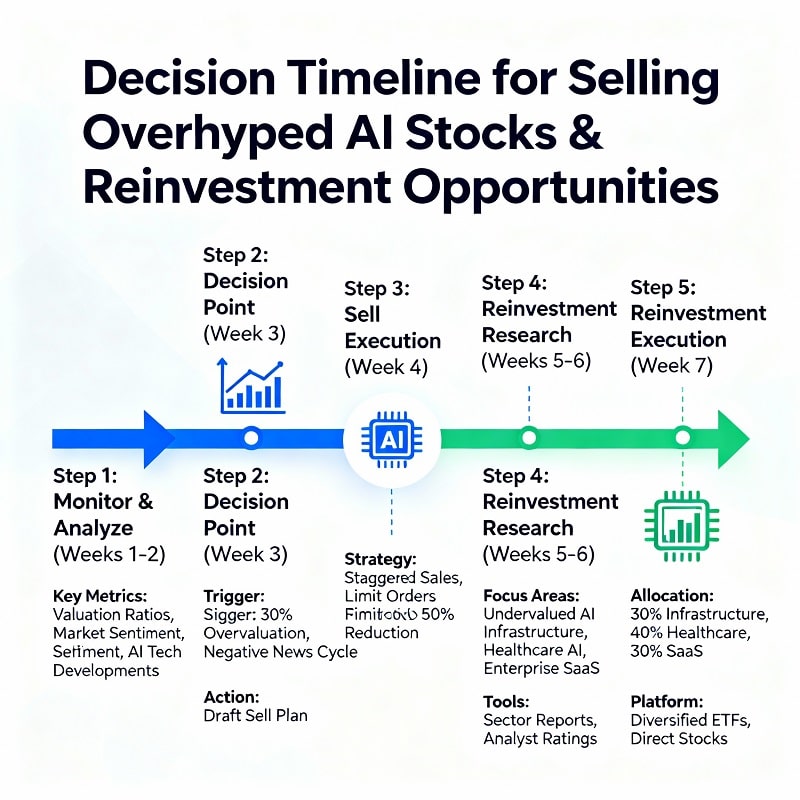How to Recognize Market Euphoria, Protect Your Gains, and Rotate into Real Value — Lessons for the Smart Investor.
Key Takeaways
-
AI stocks aren’t dead — but the easy money phase is over. The AI boom of 2023–2025 created trillion-dollar winners and a swarm of imitators trading at absurd valuations.
-
Most investors confuse innovation with investability. A great technology doesn’t always mean a great stock.
-
There are clear signals when hype turns into hazard — valuation compression, insider selling, narrowing market breadth, and capital rotation.
-
The real opportunity now lies in “Sell This, Buy That” positioning. That means exiting crowded trades and reallocating into underappreciated global sectors with long-term tailwinds.
-
Eric Fry’s philosophy applies perfectly now: go where money will be made next, not where it’s already been made.
The Problem Every Investor Faces Right Now
If you’ve made money on AI stocks in the past year, you’re not alone. If you’re nervous about giving those gains back, you’re also not alone.
Every cycle produces a moment like this — when euphoria meets exhaustion. We saw it with dot-coms in 2000, housing in 2006, crypto in 2021… and now AI in 2025.
AI has changed the world — but it’s also changed investor psychology. It’s easy to look at the charts of Nvidia, Super Micro Computer, or Palantir and think, “This is just the beginning.”
But here’s the uncomfortable truth: by the time something feels obvious, it’s often already overvalued.
A Personal Note from the Trenches
I’ve been investing professionally for over 20 years — through bubbles, busts, and booms that all looked “different this time.”
I remember in 1999, a client asked me if they should sell their Cisco shares. “It’s doubled in six months,” they said. I told them, “Maybe take a little off.”
They didn’t. Cisco went on to triple… and then lose 80% over the next two years.
The lesson? You don’t have to sell because something is great. You sell because everyone already knows it’s great — and they’ve priced it for perfection.
That’s where we are with AI stocks today.
The Anatomy of a Hype Cycle: How AI Became the New Dot-Com

Every market mania follows the same psychological pattern:
-
Discovery — a breakthrough catches attention (ChatGPT, in this case).
-
Acceleration — investors chase growth stories and future promises.
-
Euphoria — valuations detach from fundamentals.
-
Disillusionment — growth slows, earnings disappoint, rotation begins.
-
Reality — survivors consolidate and lead the next phase.
AI is sitting between stages 3 and 4 right now.
We’ve gone from “AI is the future” to “everything is AI.” And when everything is AI — nothing is special.
Nvidia, for instance, has been the poster child of the AI revolution. It deserves to be a market leader. But at 35x sales and nearly $3 trillion in market cap, the question isn’t whether it’s a great company — it’s whether it’s still a great investment.
Three Signs Your AI Stocks Are Overpriced
1. Valuations Detached from Reality
Investors love stories, but stories don’t pay dividends. When price-to-earnings ratios soar past growth expectations, you’re no longer investing — you’re speculating.
As of Q4 2025, many AI-adjacent stocks trade at forward multiples higher than during the 2021 tech peak.
-
Nvidia trades around 30x sales.
-
Palantir’s valuation assumes 20 years of uninterrupted growth.
-
Startups with minimal revenue are going public as “AI leaders.”
When you start hearing about “AI for coffee machines” or “AI-driven socks,” it’s a sign of saturation.
Valuation isn’t just about numbers — it’s about narrative exhaustion.
2. Insider Selling and Executive Cash-Outs
Follow the money — not the headlines. When insiders start selling heavily, it’s usually a signal that leadership knows valuations are peaking.
Executives at major AI companies have sold billions in stock this year while retail investors doubled down. That’s not a coincidence.
If you see a CEO selling $500 million in shares while tweeting about “a new era of AI,” take note.
3. Narrowing Breadth and Sector Fatigue
Early in a bull market, dozens of companies rise together. Late in the game, only a few leaders carry the entire sector.
In mid-2024, over 40 AI-related companies outperformed the S&P 500. By late 2025, fewer than 10 are still leading.
That’s classic breadth collapse — the kind of top-heavy behavior that signals distribution. When capital starts to flow into other sectors (energy, commodities, global small caps), that’s your exit cue.
The Smart Money Playbook: How Professionals Rotate Out of Bubbles
Professional investors don’t panic-sell. They rotate.
That means gradually trimming high-risk, overvalued assets and reallocating into sectors with better risk-adjusted upside.
It’s not about “going bearish.” It’s about going selective.
1. Trim in Stages
The best way to exit a crowded trade is in slices. Sell a third now, a third if valuations stretch further, and the final third when momentum clearly breaks.
This keeps you exposed to potential upside but protects you from full downside risk.
2. Use Strength to Exit
Amateurs sell when stocks fall. Professionals sell when stocks look strongest.
If you’re holding an AI winner that’s 100% up, don’t wait for a 30% pullback to start thinking about risk. Sell into strength — that’s when liquidity is highest.
3. Reallocate to Forgotten Markets
Here’s where Eric Fry’s “Sell This, Buy That” philosophy comes in. When one sector is crowded, there’s usually another that’s unloved and undervalued.
Right now, those markets include:
-
Commodities — especially critical metals like lithium, copper, and nickel (needed for EVs and AI hardware).
-
Energy Infrastructure — essential for powering AI data centers.
-
Global Value Plays — non-U.S. markets trading at discounts of 40–60% relative to U.S. equities.
These aren’t as exciting as AI headlines — but that’s exactly why they’re worth investigating.
Where to Reinvest: Finding the Next Wave of Asymmetric Opportunities
When overhyped sectors cool, capital doesn’t disappear — it rotates.
And over the long run, it’s that rotation that drives generational wealth shifts.
Here’s where sophisticated investors are looking now:
1. Global “Value Gaps”
Most investors are overexposed to U.S. tech. But valuation data shows international markets — especially in Asia and parts of Europe — are trading at multi-decade discounts.
Eric Fry often calls these “asymmetric setups” — places where downside risk is low but upside potential is enormous.
Think of markets like:
-
Japan, where corporate reform and dividend growth are accelerating.
-
India, now the fastest-growing major economy.
-
Brazil, with rising commodity leverage and digital infrastructure booms.
These aren’t “hype” trades — they’re value-backed, under-the-radar opportunities.
2. Hard Assets and Real Yield
Inflation didn’t vanish — it just went quiet. The next leg of global growth will favor real assets: energy, infrastructure, and metals that enable AI itself.
AI servers alone require 10x more energy than traditional computing setups. The winners here won’t be app makers — they’ll be the companies providing power, cooling, and grid capacity.
That’s where long-term capital is quietly flowing.
3. Deep Value in “Old Economy” Stocks
Every new tech boom makes investors forget the basics: balance sheets, dividends, and tangible assets. But those “boring” sectors are often where wealth quietly compounds.
While AI gets the headlines, sectors like manufacturing, logistics, and materials are trading at multi-year lows — yet generating strong free cash flow.
These are classic rotation opportunities: sell what’s popular, buy what’s profitable.
The Psychological Trap: Why Most Investors Stay Too Long

The biggest enemy of performance isn’t timing — it’s ego.
Investors hold onto winning stocks too long because they feel personal pride in “being right.” But as the saying goes: “Pigs get fat, hogs get slaughtered.”
Recognizing when a trade has moved from investment to speculation is the hardest part of this game.
The trick is to stay process-oriented:
-
Always know your exit strategy before you enter a trade.
-
Base decisions on data, not dopamine.
-
Understand that every bull market ends with stories of “just one more run.”
In my two decades of watching markets, every major top looked the same: a wall of confidence masking a quiet withdrawal of liquidity.
If you start hearing phrases like “AI will change everything forever,” it’s usually time to protect profits — not chase them.
“But AI Is the Future!”
Of course it is. So was the internet. So were smartphones. So is renewable energy.
But being the future doesn’t mean every company in the space is worth buying.
Think back to 2000. The internet was the biggest technological shift in history. But most internet stocks went bankrupt.
What survived? The firms with real cash flow, strong moats, and clear execution. The same will happen with AI.
Yes — AI is a long-term revolution. But most of the current high-fliers are trading at prices that assume a flawless future. And markets don’t price in perfection for long.
The smart move? Keep exposure to the winners — but redeploy profits into what’s next.
Action Plan: Protecting Profits and Preparing for Rotation
Here’s how to practically manage this environment:
-
Audit Your AI Exposure
Make a list of all stocks in your portfolio tied to AI themes. Check valuation multiples. Anything over 30x earnings without cash flow growth? Reassess. -
Set Trailing Stops
Use mechanical discipline. Protect 20–25% of unrealized gains on leaders. Don’t let emotion erase your hard-earned profits. -
Take Partial Profits into Strength
Selling doesn’t mean losing faith — it means managing risk. Rebalance while markets are still strong. -
Build a “Next Decade” Watchlist
Look at undervalued global sectors, commodity producers, and infrastructure plays. That’s where rotation will lead. -
Follow Analysts Who Specialize in Macro Rotation
Eric Fry’s track record includes calling the dot-com collapse, 2008 crisis, and global commodity supercycles. His approach — Sell This, Buy That — is about staying one step ahead of the herd.
That’s how professionals consistently outperform: they move capital before the crowd realizes the story has changed.
If you’re looking for specific guidance on where to reinvest your AI profits, Eric Fry’s Investment Report is a masterclass in global value rotation.
He focuses on undervalued international markets, hard assets, and overlooked growth stories — the kind of opportunities that don’t flash across your newsfeed every day.
His philosophy is simple:
“Sell what everyone else owns. Buy what no one is looking at — yet.”
That mindset has helped investors capture triple-digit gains in contrarian sectors for over two decades.
In a market obsessed with hype, that perspective is priceless.
FAQ: Managing AI Exposure and Reinvestment
Should I sell all my AI stocks?
No — trim, don’t torch. Keep exposure to high-quality names but rebalance away from the riskiest valuations.
How do I know when the AI bubble has truly popped?
Watch for three things: falling margins, negative revisions, and investor apathy. When people stop asking “Is AI the future?” — that’s when to re-enter.
Where’s the best place to reinvest profits now?
Look at global value sectors — energy, commodities, and emerging markets — where valuations are historically low and fundamentals are improving.
Is it too late to rotate into global markets?
Not at all. Valuations abroad remain near 15-year lows relative to U.S. equities. That’s long-term opportunity territory.
What’s the simplest way to apply the “Sell This, Buy That” idea?
Each quarter, identify your portfolio’s biggest gainers and reallocate a portion into sectors showing relative undervaluation.
Final Thoughts
The AI revolution isn’t ending — it’s maturing. And in markets, maturity means differentiation: leaders separate from laggards, and fundamentals replace FOMO.
The investors who thrive in this environment won’t be the loudest — they’ll be the most disciplined. They’ll sell into strength, buy underpriced assets, and stay patient while the crowd chases the next big thing.
AI was the story of the past two years. But the story of the next decade? It belongs to those who know when to sell brilliance — and where to reinvest quietly.
Because the real money isn’t made by following trends. It’s made by anticipating rotations — and acting before everyone else does.
Next Step: Start evaluating your portfolio through a contrarian lens. Protect your gains. Then study where capital is quietly flowing next. That’s how you’ll position yourself for the next wave of global wealth creation — before the headlines ever catch on.

































